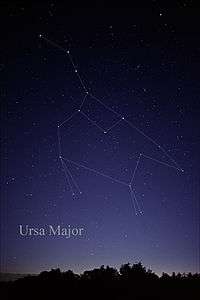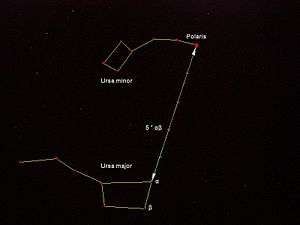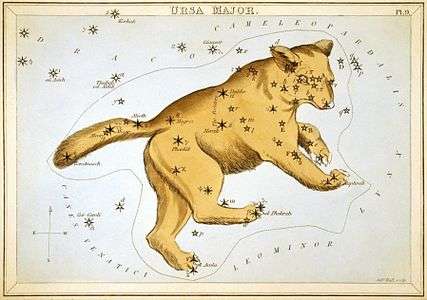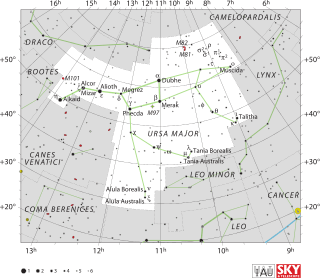Ursa Major
| Constellation | |
|
| |
| Abbreviation | UMa |
|---|---|
| Genitive | Ursae Majoris |
| Pronunciation |
/ˈɜːrsə ˈmeɪdʒər/, genitive /ˌɜːrsiː məˈdʒɒrᵻs/ |
| Symbolism | the Great Bear |
| Right ascension | 10.67 |
| Declination | +55.38 |
| Family | Ursa Major |
| Quadrant | NQ2 |
| Area | 1280 sq. deg. (3rd) |
| Main stars | 7, 20 |
| Bayer/Flamsteed stars | 93 |
| Stars with planets | 21 |
| Stars brighter than 3.00m | 7 |
| Stars within 10.00 pc (32.62 ly) | 8 |
| Brightest star | ε UMa (Alioth) (1.76m) |
| Nearest star |
Lalande 21185 (8.31 ly, 2.55 pc) |
| Messier objects | 7 |
| Meteor showers |
Alpha Ursa Majorids Leonids-Ursids |
| Bordering constellations |
Draco Camelopardalis Lynx Leo Minor Leo Coma Berenices Canes Venatici Boötes |
|
Visible at latitudes between +90° and −30°.  The Big Dipper or Plough | |
Ursa Major /ˈɜːrsə ˈmeɪdʒər/ (also known as the Great Bear) is a constellation in the northern celestial hemisphere. One of the 48 constellations listed by Ptolemy (second century AD), it remains one of the 88 modern constellations. It can be visible throughout the year in most of the northern hemisphere. Its name, Latin for "the greater (or larger) she-bear", stands as a reference to and in direct contrast with Ursa Minor, "the lesser she-bear", with which it is frequently associated in mythology and amateur astronomy. The constellation's most recognizable asterism, a group of seven relatively bright stars commonly known as the "Big Dipper", "the Wagon" or "the Plough"[1] (among others), both mimics the shape of the lesser bear (the "Little Dipper") and is commonly used as a navigational pointer towards the current northern pole star, Polaris in Ursa Minor. The Big Dipper and the constellation as a whole have mythological significance in numerous world cultures, usually as a symbol of the north.
The third largest constellation in the sky, Ursa Major is home to many deep-sky objects including seven Messier objects,[2] four other NGC objects and I Zwicky 18, which is potentially the youngest-known galaxy in the visible universe.
Characteristics
Ursa Major occupies a large area in the northern celestial hemisphere. One of the largest constellations in the night sky, its 1279.66 square degrees of surface area being equivalent to 3.10% of the total sky. The official constellation boundaries, set by Eugène Delporte in 1930, form a 28-sided irregular polygon which, according to the equatorial coordinate system, stretches between the right ascension coordinates of 08h 08.3m and 14h 29.0m and the declination coordinates of 28.30° and 73.14°.[3] It is bordered by eight other constellations: Draco to the north and northeast, Boötes to the east, Canes Venatici to the east and southeast, Coma Berenices to the southeast, Leo and Leo Minor to the south, Lynx to the southwest and Camelopardalis to the northwest. It's also the namesake of its constellation family, which includes all the constellations it borders except for Leo (a member of the Zodiac), and also Ursa Minor and Corona Borealis. The three-letter abbreviation for the constellation, as adopted by the IAU (International Astronomical Union) in 1922, is 'UMa'.
Features

Stars
The "Big Dipper"
The "Big Dipper" (a term mainly used in the United States and Canada; Plough and (historically) Charles' Wain[4] are used in the United Kingdom) is an asterism within Ursa Major composed of seven bright stars (six of them of the second magnitude or higher) that together comprise one of the best-known patterns in the sky. Like many of its common names allude to, its shape is said to resemble either a ladle, an agricultural plough or wagon; in the context of Ursa Major, they are commonly drawn to represent the hindquarters and tail of the Great Bear. Starting with the "ladle" portion of the dipper and extending clockwise (eastward in the sky) through the handle, these stars are the following:
- α Ursae Majoris, known by the Arabic name Dubhe ("the bear"), which at a magnitude of 1.79 is the 35th-brightest star in the sky and the second-brightest of Ursa Major.
- β Ursae Majoris, called Merak ("the loins of the bear"), with a magnitude of 2.37.
- γ Ursae Majoris, known as either Phecda or Phad ("thigh"), with a magnitude of 2.44.
- δ Ursae Majoris, or Megrez, meaning "root of the tail," an appropriate name given its location as the intersection of the body and tail of the bear (or the ladle and handle of the dipper).
- ε Ursae Majoris, known as Alioth, a name which refers not to a bear but to a "black horse," the name corrupted from the original and mis-assigned to the similarly named Alcor, the naked-eye binary companion of Mizar.[5] Alioth is the brightest star of Ursa Major and the 33rd-brightest in the sky, with a magnitude of 1.76. It is also the brightest of the "peculiar A (Ap) stars," magnetic stars whose chemical elements are either depleted or enhanced, and appear to change as the star rotates.[6]
- ζ Ursae Majoris, Mizar, the second star in from the end of the handle of the Big Dipper, and the constellation's fourth-brightest star. Mizar, which means "girdle," forms a famous double star, with its optical companion Alcor (80 Ursae Majoris), the two of which were termed the "horse and rider" by the Arabs. The ability to resolve the two stars with the naked eye is often quoted as a test of eyesight, although even people with quite poor eyesight can see the two stars.
- η Ursae Majoris, known as either Alkaid or Benetnash, both meaning the "end of the tail." With a magnitude of 1.85, Alkaid is the third-brightest star of Ursa Major.[7][8]
Except for Dubhe and Alkaid, the stars of the Big Dipper all have proper motions heading toward a common point in Sagittarius. A few other such stars have been identified, and together they are called the Ursa Major Moving Group.
The stars Merak (β Ursae Majoris) and Dubhe (α Ursae Majoris) are known as the "pointer stars" because they are helpful for finding Polaris, also known as the North Star or Pole Star. By visually tracing a line from Merak through Dubhe and continuing, one's eye will land on Polaris, accurately indicating true north.
Other stars
Another asterism known as the "Three Leaps of the Gazelle"[9] is recognized in Arab culture, a series of three pairs of stars found along the southern border of the constellation; From southeast to southwest, the "first leap", comprising ν and ξ Ursae Majoris (Alula Borealis and Australis, respectively); the "second leap", comprising λ and μ Ursae Majoris (Tania Borealis and Australis); and the "third leap", comprising ι and κ Ursae Majoris, (Talitha Borealis and Australis).
W Ursae Majoris is the prototype of a class of contact binary variable stars, and ranges between 7.75m and 8.48m.
47 Ursae Majoris is a Sun-like star with a three-planet system.[10] 47 Ursae Majoris b, discovered in 1996, orbits every 1078 days and is 2.53 times the mass of Jupiter.[11] 47 Ursae Majoris c, discovered in 2001, orbits every 2391 days and is 0.54 times the mass of Jupiter.[12] 47 Ursae Majoris d, discovered in 2010, has an uncertain period, lying between 8907 and 19097 days; it is 1.64 times the mass of Jupiter.[13] The star is of magnitude 5.0 and is approximately 46 light-years from Earth.[10]
The star TYC 3429-697-1 (9h 40m 44s; 48°14′2″, located to the east of θ Ursae Majoris and to the southwest of the "Big Dipper") has been recognized as the state star of Delaware, and is informally known as the Delaware Diamond.[14]
Deep-sky objects
Several bright galaxies are found in Ursa Major, including the pair Messier 81 (one of the brightest galaxies in the sky) and Messier 82 above the bear's head, and Pinwheel Galaxy (M101), a spiral northeast of η Ursae Majoris. The spiral galaxies Messier 108 and Messier 109 are also found in this constellation. The bright planetary nebula Owl Nebula (M97) can be found along the bottom of the bowl of the Big Dipper.
M81 is a nearly face-on spiral galaxy 11.8 million light-years from Earth. Like most spiral galaxies, it has a core made up of old stars, with arms filled with young stars and nebulae. Along with M82, it is a part of the galaxy cluster closest to the Local Group.
M82 is a galaxy that is interacting gravitationally with M81. It is the brightest infrared galaxy in the sky.[15] SN 2014J, an apparent Type Ia supernova, was observed in M82 on 21 January 2014.[16]
M97, also called the Owl Nebula, is a planetary nebula 1,630 light-years from Earth; it has a magnitude of approximately 10. It was discovered in 1781 by Pierre Méchain.[17]
M101, also called the Pinwheel Galaxy, is a face-on spiral galaxy located 25 million light-years from Earth. It was discovered by Pierre Méchain in 1781. Its spiral arms have regions with extensive star formation and have strong ultraviolet emissions.[15] It has an integrated magnitude of 7.5, making it visible in both binoculars and telescopes, but not to the naked eye.[18]
NGC 2787 is a lenticular galaxy at a distance of 24 million light-years. Unlike most lenticular galaxies, NGC 2787 has a bar at its center. It also has a halo of globular clusters, indicating its age and relative stability.[15]
NGC 3079 is a starburst spiral galaxy located 52 million light-years from Earth. It has a horseshoe-shaped structure at its center that indicates the presence of a supermassive black hole. The structure itself is formed by superwinds from the black hole.[15]
NGC 3310 is another starburst spiral galaxy located 50 million light-years from Earth. Its bright white color is caused by its higher than usual rate of star formation, which began 100 million years ago after a merger. Studies of this and other starburst galaxies have shown that their starburst phase can last for hundreds of millions of years, far longer than was previously assumed.[15]
NGC 4013 is an edge-on spiral galaxy located 55 million light-years from Earth. It has a prominent dust lane and has several visible star forming regions.[15]
I Zwicky 18 is a young dwarf galaxy at a distance of 45 million light-years. The youngest-known galaxy in the visible universe, I Zwicky 18 is about 4 million years old, about one-thousandth the age of the Solar System. It is filled with star forming regions which are creating many hot, young, blue stars at a very high rate.[15]
The Hubble Deep Field is located to the northeast of δ Ursae Majoris.
Meteor showers
The Kappa Ursae Majorids are a newly discovered meteor shower, peaking between November 1 and November 10.[19]
Extrasolar planets
HD 80606, a sun-like star in a binary system, orbits a common center of gravity with its partner, HD 80607; the two are separated by 1,200 AU on average. Research conducted in 2003 indicates that its sole planet, HD 80606 b is a future hot Jupiter, modeled to have evolved in a perpendicular orbit around 5 AU from its sun. The 4-Jupiter mass planet is projected to eventually move into a circular, more aligned orbit via the Kozai mechanism. However, it is currently on an incredibly eccentric orbit that ranges from approximately one astronomical unit at its apoapsis and six stellar radii at periapsis.[20]
History
Ursa Major has been reconstructed as an Indo-European constellation.[21] It was one of the 48 constellations listed by the 2nd century AD astronomer Ptolemy in his Almagest. It is mentioned by such poets as Homer, Spenser, Shakespeare, Tennyson and Federico Garcia Lorca (in "Song for the Moon"[22]). The Finnish epic Kalevala mentions it, Vincent van Gogh painted it. In 2009, the American rock band Third Eye Blind named their fourth album, Ursa Major, after the constellation. It may be mentioned in the biblical book of Job, dated between the 7th and 4th centuries BC, although this is disputed.[23]
Mythology

The constellation of Ursa Major has been seen as a bear by many distinct civilizations.[24] This may stem from a common oral tradition stretching back more than 13,000 years.[25] Using statistical and phylogenetic tools, Julien d'Huy reconstructs the following Palaeolithic state of the story: "There is an animal that is a horned herbivore, especially an elk. One human pursues this ungulate. The hunt locates or get to the sky. The animal is alive when it is transformed into a constellation. It forms the Big Dipper".[26]
In Burmese, Pucwan Tārā (pronounced "bazun taja") is the name of a constellation comprising stars from the head and forelegs of Ursa Major; pucwan is a general term for a crustacean, such as prawn, shrimp, crab, lobster, etc.
In Roman mythology, Jupiter (the king of the gods) lusts after a young woman named Callisto, a nymph of Diana. Juno, Jupiter's jealous wife, discovers that Callisto has a son named Arcas, and believes it is by Jupiter.[27] Juno then transforms the beautiful Callisto into a bear so she no longer attracts Jupiter. Callisto, while in bear form, later encounters her son Arcas. Arcas almost shoots the bear, but to avert the tragedy, Jupiter turns Arcas into a bear too and puts them both in the sky, forming Ursa Major and Ursa Minor. Callisto is Ursa Major and her son, Arcas, is Ursa Minor. In ancient times the name of the constellation was Helike, ("turning"), because it turns around the Pole. In Book Two of Lucan it is called Parrhasian Helice, since Callisto came from Parrhasia in Arcadia, where the story is set.[28] The Odyssey notes that it is the sole constellation that never sinks below the horizon and "bathes in the Ocean's waves", so it is used as a celestial reference point for navigation.[29] It is also referred to as the "Wain".[30]
One of the few star groups mentioned in the Bible (Job 9:9; 38:32; — Orion and the Pleiades being others), Ursa Major was also pictured as a bear by the Jewish peoples. ("The Bear" was translated as "Arcturus" in the Vulgate and it persisted in the KJV.)
In Finnish language, the asterism is sometimes called with its old Finnish name, Otava. The meaning of the name has been almost forgotten in Modern Finnish; it means a salmon weir. Ancient Finns believed the bear (Ursus arctos) was lowered to earth in a golden basket off the Ursa Major, and when a bear was killed, its head was positioned on a tree to allow the bear's spirit to return to Ursa Major.
The Iroquois Native Americans interpreted Alioth, Mizar, and Alkaid as three hunters pursuing the Great Bear. According to one version of their myth, the first hunter (Alioth) is carrying a bow and arrow to strike down the bear. The second hunter (Mizar) carries a large pot — the star Alcor — on his shoulder in which to cook the bear while the third hunter (Alkaid) hauls a pile of firewood to light a fire beneath the pot.
The Wampanoag people(Algonquian) Native Americans referred to Ursa Major as "maske", meaning "bear" according to Thomas Morton in The New England Canaan.[31]
In Hinduism, Ursa Major is known as Saptarshi, each of the stars representing one of the Saptarshis or Seven Sages viz. Bhrigu, Atri, Angirasa, Vasishta, Pulastya, Pulalaha and Kratu. The fact that the two front stars of the constellations point to the pole star is explained as the boon given to the boy sage Dhruva by Lord Vishnu.
In Javanese, as known as "Bintang Kartika". This name comes from Sanskrit which refers "krttikã" the same star cluster. In ancient Javanese this brightest seven stars are known as Lintang Wuluh, literally means "seven stars". This star cluster is so popular because its emergence into the sky signals the time marker for planting.
In South Korea, the constellation is referred to as "the seven stars of the north". In the related myth, a widow with seven sons found comfort with a widower, but to get to his house required crossing a stream. The seven sons, sympathetic to their mother, placed stepping stones in the river. Their mother, not knowing who put the stones in place, blessed them and, when they died, they became the constellation.
In Shinto, the 7 largest stars of Ursa Major belong to Amenominakanushi, the oldest and most powerful of all kami.
In China and Japan, the Big Dipper is called the "North Dipper" 北斗 (Chinese: běidǒu, Japanese: hokuto), and in ancient times, each one of the seven stars had a specific name, often coming themselves from ancient China:
- "Pivot" 樞 (C: shū J: sū) is for Dubhe (Alpha Ursae Majoris)
- "Beautiful jade" 璇 (C: xuán J: sen) is for Merak (Beta Ursae Majoris)
- "Pearl" 璣 (C: jī J: ki) is for Phecda (Gamma Ursae Majoris)
- "Authority" 權 (C: quán J: ken) is for Megrez (Delta Ursae Majoris)
- "Measuring rod of jade" 玉衡 (C: yùhéng J: gyokkō) is for Alioth (Epsilon Ursae Majoris)
- "Opening of the Yang" 開陽 (C: kāiyáng J: kaiyō) is for Mizar (Zeta Ursae Majoris)
- Alkaid (Eta Ursae Majoris) has several nicknames: "Sword" 劍 (C: jiàn J: ken) (short form from "End of the sword" 劍先 (C: jiàn xiān J: ken saki)), "Flickering light" 搖光 (C: yáoguāng J: yōkō), or again "Star of military defeat" 破軍星 (C: pójūn xīng J: hagun sei), because travel in the direction of this star was regarded as bad luck for an army.[32]
In Theosophy, it is believed the Seven Stars of the Pleiades focus the spiritual energy of the Seven Rays from the Galactic Logos to the Seven Stars of the Great Bear, then to Sirius, then to the Sun, then to the god of Earth (Sanat Kumara), and finally through the seven Masters of the Seven Rays to the human race.[33]
The Lakota people call the constellation Wičhákhiyuhapi, or "Great Bear"."[34]

Graphic visualisation
In European star charts, the constellation was visualized with the 'square' of the Big Dipper forming the bear's body and the chain of stars forming the Dipper's "handle" as a long tail. However, bears do not have long tails, and Jewish astronomers considered Alioth, Mizar, and Alkaid instead to be three cubs following their mother, while the Native Americans saw them as three hunters.

Noted children's book author H. A. Rey, in his 1952 book The Stars: A New Way to See Them, (ISBN 0-395-24830-2) had a different asterism in mind for Ursa Major, that instead had the "bear" image of the constellation oriented with Alkaid as the tip of the bear's nose, and the "handle" of the Big Dipper part of the constellation forming the outline of the top of the bear's head and neck, rearwards to the shoulder,[35] potentially giving it the longer head and neck of a polar bear. Because of Rey's book, many amateur astronomers have come to accept Rey's star chart interpretation of Ursa Major, dropping the idea of the Big Dipper's "handle" as being the hind end of the bear, with a non-natural "tail" extending rearwards.
 Ursa Major as depicted in Urania's Mirror, a set of constellation cards published in London c.1825.
Ursa Major as depicted in Urania's Mirror, a set of constellation cards published in London c.1825. Johannes Hevelius drew Ursa Major as if being viewed from outside the celestial sphere.
Johannes Hevelius drew Ursa Major as if being viewed from outside the celestial sphere.
 flag of Alaska
flag of Alaska
Ursa Major is also pictured as the Starry Plough, the Irish Flag of Labour, adopted by James Connolly's Irish Citizen Army in 1916, which shows the constellation on a blue background; on the state flag of Alaska; and on the House of Bernadotte's variation of the coat of arms of Sweden.
See also
References
- Citations
- ↑ Planet earth and the universe. readers digest.
- ↑ Thompson & Thompson 2007, pp. 462.
- ↑ "Ursa Major, Constellation Boundary". The Constellations. International Astronomical Union. Retrieved 16 August 2015.
- ↑
 Ripley, George; Dana, Charles A., eds. (1879). "Charles's Wain". The American Cyclopædia.
Ripley, George; Dana, Charles A., eds. (1879). "Charles's Wain". The American Cyclopædia.
- ↑ Prof. Jim Kaler, Stars: "Alioth" (2009-09-16), http://stars.astro.illinois.edu/sow/alioth.html.
- ↑ See Kaler.
- ↑ See generally Mark R. Chartrand III (1983) Skyguide: A Field Guide for Amateur Astronomers, p. 195 (ISBN 0-307-13667-1).
- ↑ Ridpath, at p. 136.
- ↑ "Ursa Major & Ursa Minor". Winter Sky Tour.
- 1 2 Levy 2005, p. 67.
- ↑ "Planet 47 Uma b". The Extrasolar Planet Encyclopaedia. Paris Observatory. 11 July 2012. Retrieved 15 July 2012.
- ↑ "Planet 47 Uma c". The Extrasolar Planet Encyclopaedia. Paris Observatory. 11 July 2012. Retrieved 15 July 2012.
- ↑ "Planet 47 Uma d". The Extrasolar Planet Encyclopaedia. Paris Observatory. 11 July 2012. Retrieved 15 July 2012.
- ↑ Delaware Facts & Symbols - Delaware Miscellaneous Symbols, delaware.gov. Accessed on line August 17, 2015.
- 1 2 3 4 5 6 7 Wilkins, Jamie; Dunn, Robert (2006). 300 Astronomical Objects: A Visual Reference to the Universe (1st ed.). Buffalo, New York: Firefly Books. ISBN 978-1-55407-175-3.
- ↑ http://www.astronomerstelegram.org/?read=5786
- ↑ Levy 2005, pp. 129–130.
- ↑ Seronik, Gary (July 2012). "M101: A Bear of a Galaxy". Sky & Telescope. 124 (1).
- ↑ Jenniskens, Peter (September 2012). "Mapping Meteoroid Orbits: New Meteor Showers Discovered". Sky & Telescope: 23.
- ↑ Laughlin, Greg (May 2013). "How Worlds Get Out of Whack". Sky and Telescope: 29.
- ↑ Mallory, J.P.; Adams, D.Q. (August 2006). "Chapter 8.5: The Physical Landscape of the Proto-Indo-Europeans". Oxford Introduction to Proto-Indo-European and the Proto-Indo-European World. Oxford, GBR: Oxford University Press. p. 131. ISBN 9780199287918. OCLC 139999117.
The most solidly ‘reconstructed’ Indo-European constellation is Ursa Major, which is designated as ‘The Bear’ (Chapter 9) in Greek and Sanskrit (Latin may be a borrowing here), although even the latter identification has been challenged.
- ↑ http://www.ciudadseva.com/textos/poesia/esp/lorca/cancion_para_la_luna.htm
- ↑ Botterweck, G. Johannes, ed. (1994). Theological Dictionary of the Old Testament, Volume 7. Wm. B. Eerdmans. pp. 79–80. ISBN 9780802823311.
- ↑ Gibbon, William B. (1964). "Asiatic parallels in North American star lore: Ursa Major". Journal of American Folklore. 77 (305): 236–250. doi:10.2307/537746.
- ↑ Bradley E Schaefer, The Origin of the Greek Constellations: Was the Great Bear constellation named before hunter nomads first reached the Americas more than 13,000 years ago?, Scientific American, November 2006, reviewed at The Origin of the Greek Constellations; Yuri Berezkin, The cosmic hunt: variants of a Siberian – North-American myth. Folklore, 31, 2005: 79-100.
- ↑ d'Huy Julien, Un ours dans les étoiles: recherche phylogénétique sur un mythe préhistorique, Préhistoire du sud-ouest, 20 (1), 2012: 91-106; A Cosmic Hunt in the Berber sky : a phylogenetic reconstruction of Palaeolithic mythology, Les Cahiers de l'AARS, 15, 2012.
- ↑ "The Myths of Ursa Major, The Great Bear | AAVSO". AAVSO. Retrieved 2016-04-24.
- ↑ Hamilton, Edith Mythology New American Library, New York, 1942, chapter 21 (Callisto).
- ↑ Homer, Odyssey, book 5, 273
- ↑ Mandelbaum, Allen; translator (1990). The Odyssey of Homer. New York City: Bantam Dell. ISBN 0-553-21399-7.
- ↑ https://openlibrary.org/books/OL7142058M/The_new_English_Canaan_of_Thomas_Morton
- ↑ The Bansenshukai, written in 1676 by the ninja master Fujibayashi Yasutake, speak several times about these stars, and show a traditional picture of the Big Dipper in his book 8, volume 17, speaking about astronomy and meteorology (from Axel Mazuer's translation).
- ↑ Baker, Dr. Douglas The Seven Rays:Key to the Mysteries 1952
- ↑ Ullrich, Jan, ed. (2011). New Lakota Dictionary (2nd ed.). Bloomington, IN: Lakota Language Consortium. p. 956. ISBN 978-0-9761082-9-0. LCCN 2008922508.
- ↑ Representation of H.A. Rey's asterism for Ursa Major
- Bibliography
- Levy, David H. (2005). Deep Sky Objects. Prometheus Books. ISBN 1-59102-361-0.
- Thompson, Robert; Thompson, Barbara (2007). Illustrated Guide to Astronomical Wonders: From Novice to Master Observer. O'Reilly Media, Inc. ISBN 0-596-52685-7.
Further reading
- Ian Ridpath and Wil Tirion (2007). Stars and Planets Guide, Collins, London. ISBN 978-0-00-725120-9. Princeton University Press, Princeton. ISBN 978-0-691-13556-4.
External links
| Wikimedia Commons has media related to Ursa Major. |
- The Deep Photographic Guide to the Constellations: Ursa Major
- AAVSO: The Myths of Ursa Major
- The Origin of the Greek Constellations
- Star Tales – Ursa Major
- Ursa Major at Constellation Guide
- Warburg Institute Iconographic Database (over 180 medieval and early modern images of Ursa Major)
Coordinates: ![]() 10h 40m 12s, +55° 22′ 48″
10h 40m 12s, +55° 22′ 48″
